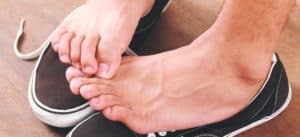
Our feet are our main mode of transportation; when they hurt, we hurt. Corns and calluses are a common condition that tends to affect women more than men. Both corns and calluses are hard areas of skin that develop as a response to pressure and/or friction, usually from ill-fitting shoes. Neither corns nor calluses are dangerous, but they can be uncomfortable and cause irritation. Both conditions are common among people who tend to have sweaty feet, stand for longer periods of time, and who wear shoes that don’t properly fit. It’s easy to get the two confused with each other but they do have different characteristics.
Corns have a very distinct shape and can be more painful than calluses. Corns are typically a small patch of thickened dead skin with a hard center. They can occur at pressure points and can commonly be found on the bottom of your feet and on the side of your toes. Seed corns have a tiny, hard callus that can be very tender, especially if it’s on the part of the foot that bears the most weight.
A callus is the thickening of the outermost layer of skin. Calluses can develop anywhere with repeated friction and pressure, the most common place for calluses to occur are hands and feet. Calluses usually are yellow or pale in color and tend to be lumpy to touch. Calluses are bigger and wider than corns and do not have defined edges. Calluses often times develop on the balls or heels of your feet and usually on the palms of your hands. People who work with their hands frequently or athletes (like gymnasts) usually have calluses on their hands due to the constant friction of their daily tasks or training.
Pumice stones or even an over-the-counter topical medication can be used to help treat corns and calluses without seeing a doctor. Please note, that any discomfort caused by calluses or corns need to be brought to the attention of your doctor. While corns and calluses are annoying and uncomfortable, they are the body’s way of protecting the sensitive skin of your feet. Take extra precautions such as clean, dry socks and properly fitting shoes to help prevent corns and calluses. If you find yourself standing for an extended period of time, take short breaks to give your feet a rest.
If you have calluses or corns that are causing extreme discomfort while you walk, or you’re ready to get treatment to help remove them, please call our office to schedule your consultation today.
Disclaimer: This blog provides general information and discussion about medical, cosmetic, mohs, and surgical dermatology. The words and other content provided in this blog, and in any linked materials, are not intended and should not be construed as medical advice. If the reader or any other person has a medical concern, he or she should consult with an appropriately-licensed dermatologist or other health care worker.
